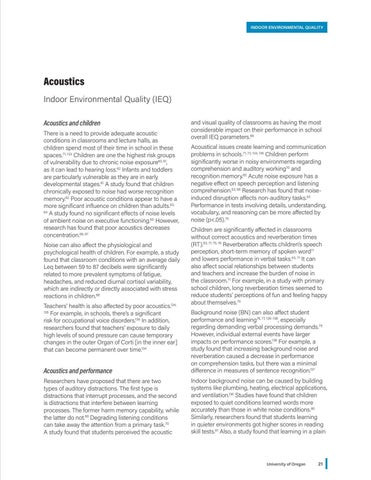INDOOR ENVIRONMENTAL QUALITY
Acoustics Indoor Environmental Quality (IEQ) Acoustics and children There is a need to provide adequate acoustic conditions in classrooms and lecture halls, as children spend most of their time in school in these spaces.71, 133 Children are one the highest risk groups of vulnerability due to chronic noise exposure60, 61, as it can lead to hearing loss.62 Infants and toddlers are particularly vulnerable as they are in early developmental stages.61 A study found that children chronically exposed to noise had worse recognition memory.62 Poor acoustic conditions appear to have a more significant influence on children than adults.63, 64 A study found no significant effects of noise levels of ambient noise on executive functioning.65 However, research has found that poor acoustics decreases concentration.66, 67 Noise can also affect the physiological and psychological health of children. For example, a study found that classroom conditions with an average daily Leq between 59 to 87 decibels were significantly related to more prevalent symptoms of fatigue, headaches, and reduced diurnal cortisol variability, which are indirectly or directly associated with stress reactions in children.68 Teachers’ health is also affected by poor acoustics.134, 135 For example, in schools, there’s a significant risk for occupational voice disorders.136 In addition, researchers found that teachers’ exposure to daily high levels of sound pressure can cause temporary changes in the outer Organ of Corti [in the inner ear] that can become permanent over time.134
and visual quality of classrooms as having the most considerable impact on their performance in school overall IEQ parameters.66 Acoustical issues create learning and communication problems in schools.71, 73, 134, 136 Children perform significantly worse in noisy environments regarding comprehension and auditory working70 and recognition memory.62 Acute noise exposure has a negative effect on speech perception and listening comprehension.63, 66 Research has found that noiseinduced disruption affects non-auditory tasks.63 Performance in tests involving details, understanding, vocabulary, and reasoning can be more affected by noise (p<.05).70 Children are significantly affected in classrooms without correct acoustics and reverberation times (RT).63, 71, 75, 76 Reverberation affects children’s speech perception, short-term memory of spoken word71 and lowers performance in verbal tasks.63, 71 It can also affect social relationships between students and teachers and increase the burden of noise in the classroom.71 For example, in a study with primary school children, long reverberation times seemed to reduce students’ perceptions of fun and feeling happy about themselves.75
Acoustics and performance
Background noise (BN) can also affect student performance and learning76, 77, 136–138, especially regarding demanding verbal processing demands.79 However, individual external events have larger impacts on performance scores.138 For example, a study found that increasing background noise and reverberation caused a decrease in performance on comprehension tasks, but there was a minimal difference in measures of sentence recognition.137
Researchers have proposed that there are two types of auditory distractions. The first type is distractions that interrupt processes, and the second is distractions that interfere between learning processes. The former harm memory capability, while the latter do not.69 Degrading listening conditions can take away the attention from a primary task.70 A study found that students perceived the acoustic
Indoor background noise can be caused by building systems like plumbing, heating, electrical applications, and ventilation.136 Studies have found that children exposed to quiet conditions learned words more accurately than those in white noise conditions.80 Similarly, researchers found that students learning in quieter environments got higher scores in reading skill tests.81 Also, a study found that learning in a plain
University of Oregon
21
